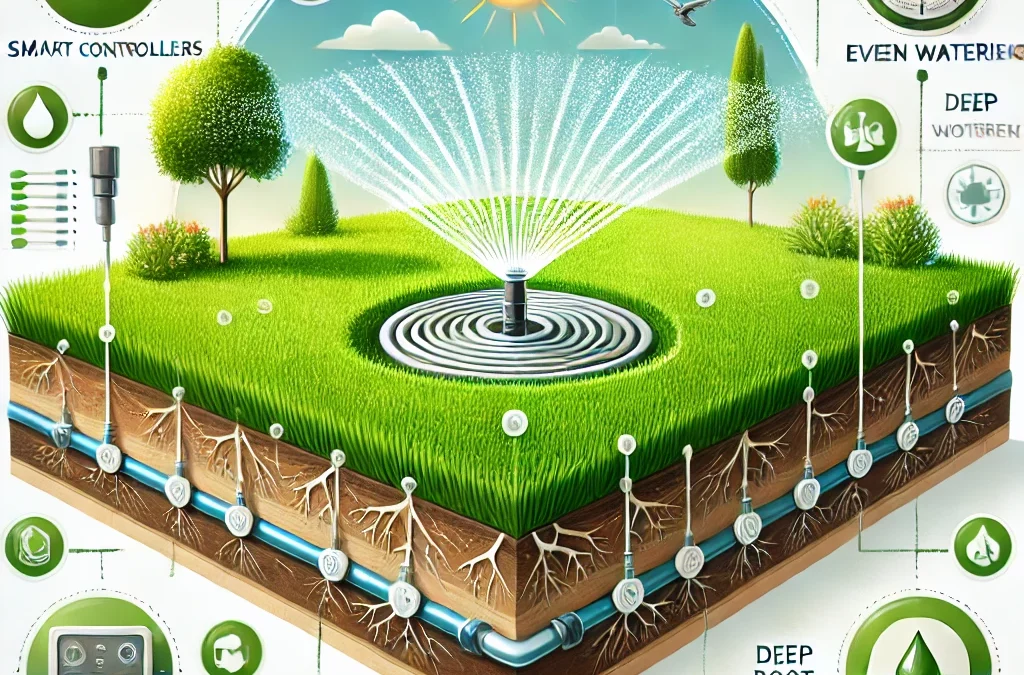Smart Lawn Irrigation in Seattle: How to Water for a Greener, Healthier Yard
Watering your lawn might seem simple—just turn on the sprinklers and let them run, right?
Not exactly.
In Seattle’s unique climate and soil conditions, how and when you irrigate your lawn has a big impact on its health, appearance, and long-term resilience. Too little water and your grass becomes stressed and patchy. Too much, and you create soggy, compacted soil where pests and moss thrive.
At Seattle Sustainable Landscapes, we help homeowners take the guesswork out of lawn irrigation with smarter sprinkler setups and water-wise lawn care strategies that work with the soil—not against it.
Here’s everything you need to know about lawn irrigation, sprinkler systems, and how proper watering fits into an eco-conscious lawn care plan. Contact Us Here
Why Lawn Irrigation Matters in the Pacific Northwest
Seattle may be famous for its rain, but from late spring through early fall, lawns are mostly on their own. July and August, in particular, bring long dry spells and little rainfall—putting cool-season grasses under real stress.
💧 Lawns in our region need about 1 to 1.5 inches of water per week to stay green and healthy through the dry months.
If you don’t supplement with irrigation, your lawn may go dormant (turn brown) or become more vulnerable to pests, weeds, and root die-off.
Common Lawn Irrigation Mistakes
Many homeowners overwater or water inefficiently, which can lead to:
- Shallow root systems, making grass more prone to drought and disease
- Runoff and wasted water, especially on sloped or compacted lawns
- Moss and fungus problems, especially when lawns are watered at night
- Encouragement of grubs, which thrive in cool, moist soil
Fixing these issues starts with using the right techniques and tools—especially your sprinkler system.
How to Water Your Lawn Effectively
✅ Water Deeply and Infrequently
It’s better to water less often but more deeply. This encourages roots to grow down into the soil where moisture is more consistent, rather than staying shallow and vulnerable.
✅ Use the Cycle and Soak Method
Seattle’s clay-heavy soils absorb water slowly. Watering too long at once often leads to runoff rather than absorption. Instead, break irrigation into shorter cycles:
- Water for 5–10 minutes
- Wait 30–60 minutes
- Repeat until the soil is soaked 6–8 inches deep
This approach reduces runoff and ensures water actually reaches the roots.
✅ Water Early in the Morning
The best time to water your lawn is between 5 a.m. and 9 a.m.
- Less evaporation
- Lower wind
- Grass has time to dry during the day, reducing disease risk
Avoid nighttime watering, which leaves the lawn damp for too long and creates ideal conditions for moss, mildew, and fungus.
How Sprinkler Systems Support Smart Lawn Care
A properly designed sprinkler system can make all the difference when it comes to efficiency, water conservation, and lawn health.
Here’s what to look for in a smart lawn sprinkler setup:
✔️ Zone-Specific Coverage
Different parts of your yard may need different amounts of water. Shady areas retain moisture longer than sunny slopes, for example. Use zones to dial in your watering needs by area.
✔️ Pressure-Regulated Heads
These help deliver consistent water without misting or overspray, which can waste water and lead to uneven growth.
✔️ Smart Controllers
Modern irrigation controllers can:
- Adjust schedules based on weather
- Delay watering during rain
- Track water usage
We recommend systems like Rachio or Hunter Hydrawise, which offer app-based control and are perfect for the tech-savvy homeowner.
✔️ Regular Maintenance
Sprinkler heads can clog, tilt, or break over time. We recommend a spring inspection and periodic mid-season checks to ensure your system is running efficiently.
How Proper Irrigation Supports Lawn Health
When done right, irrigation is more than just watering—it’s a key part of a holistic lawn care plan. A well-irrigated lawn will:
- Grow deeper, stronger roots
- Better resist summer heat and drought
- Recover more quickly from foot traffic and mowing
- Outcompete weeds, moss, and pests naturally
But remember: irrigation alone won’t fix poor soil or a struggling lawn. That’s why we integrate watering best practices into full-service lawn care packages that include:
- Soil testing and organic amendments
- Aeration and compost topdressing to improve moisture retention
- Overseeding with drought-resistant grass varieties
- Beneficial nematodes to reduce pests without synthetic chemicals
What About Water Restrictions?
Many Seattle-area cities implement seasonal watering restrictions to conserve water. Having an efficient irrigation system—and following best practices like early morning watering and cycle-and-soak—can help you stay compliant while still keeping your lawn healthy. There is even a rebate program through the Saving Water Partnership.
We can help you program your system to meet local guidelines and avoid penalties.
Final Thoughts: Lawn Irrigation with Purpose
Irrigation isn’t just about keeping grass green—it’s about supporting the life in your soil, growing healthier turf, and using resources wisely.
At Seattle Sustainable Landscapes, we help homeowners design and manage smart irrigation systems that align with their lawn goals and values. Whether you’re installing a new sprinkler system or just looking to fine-tune your watering habits, we’re here to help you create a thriving lawn that respects the environment—and your water bill.
Ready to Upgrade Your Lawn’s Irrigation?
Let’s make your watering routine smarter, more sustainable, and more effective.
📞 Contact Seattle Sustainable Landscapes today to schedule a sprinkler system audit or learn more about our lawn care and irrigation packages.
Click here to go back to our Blog Page
Click here to go back to our company Home Page
Contact Us for more information!

